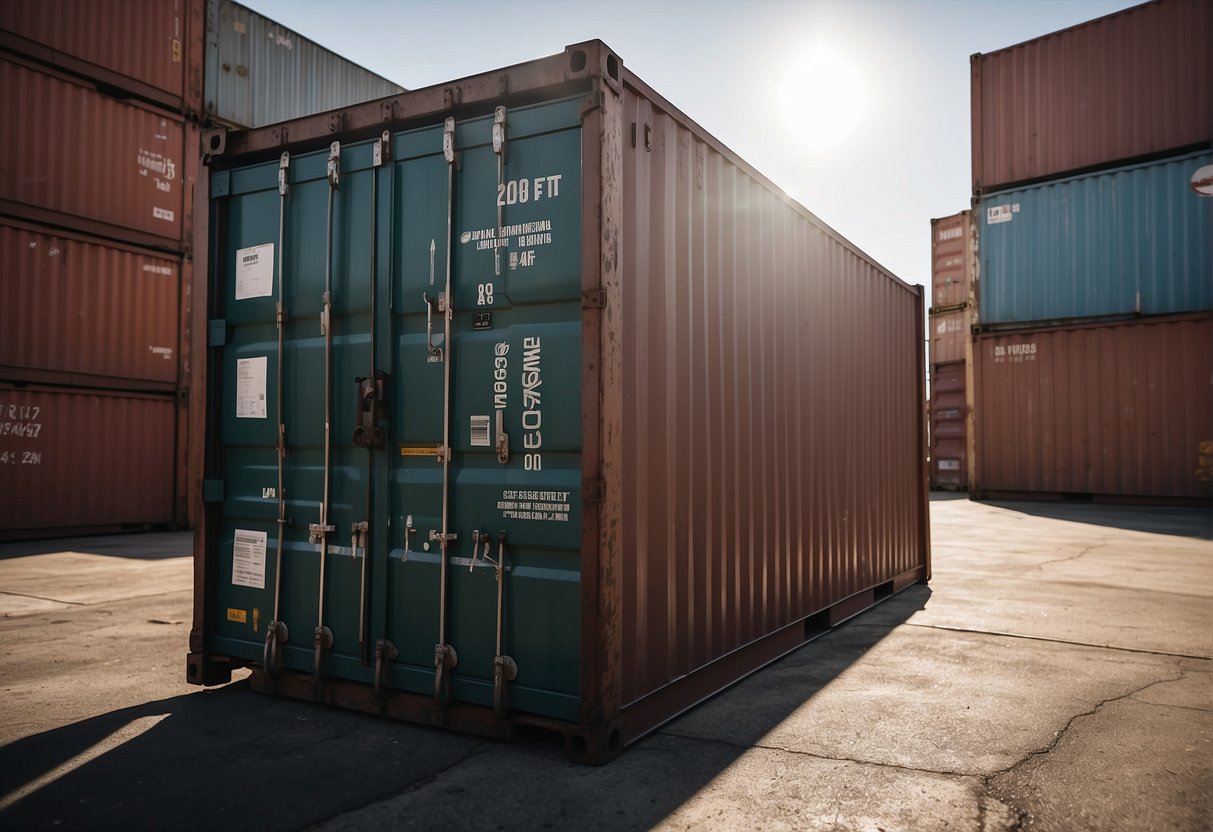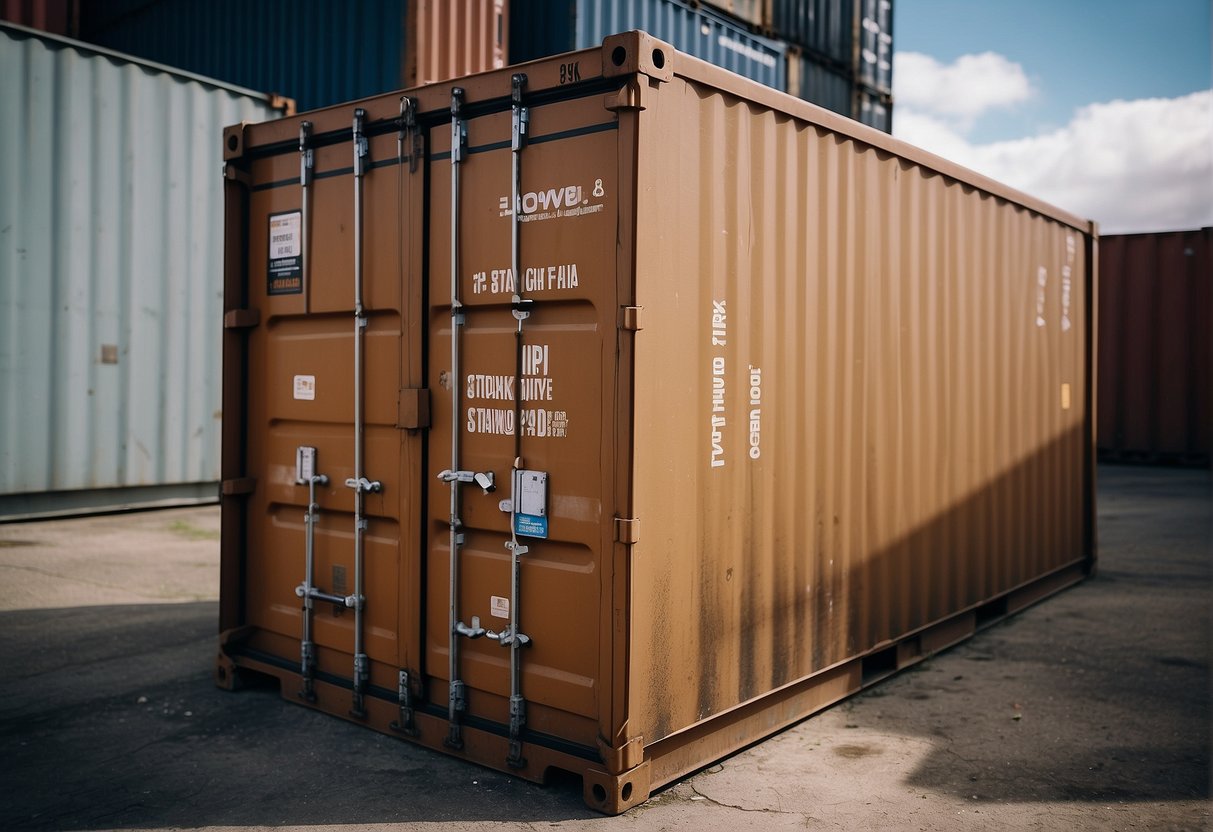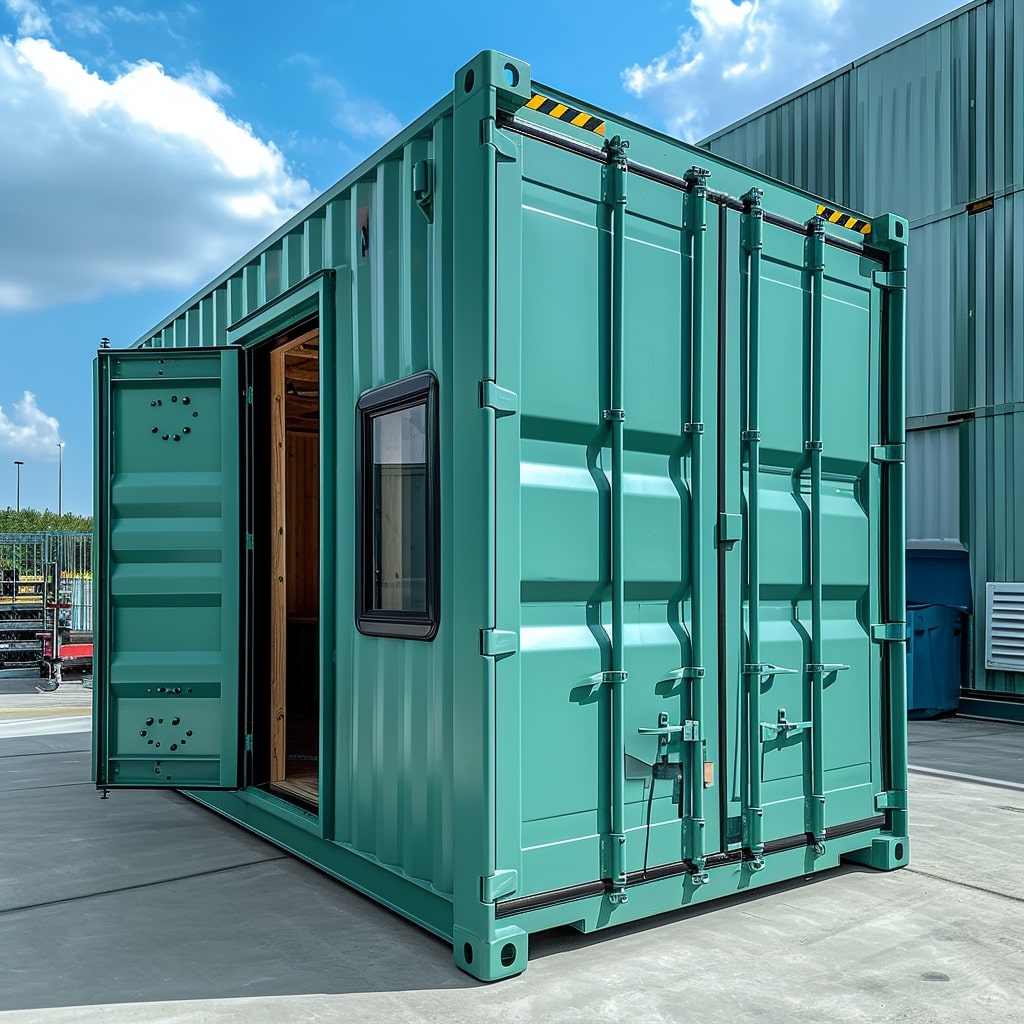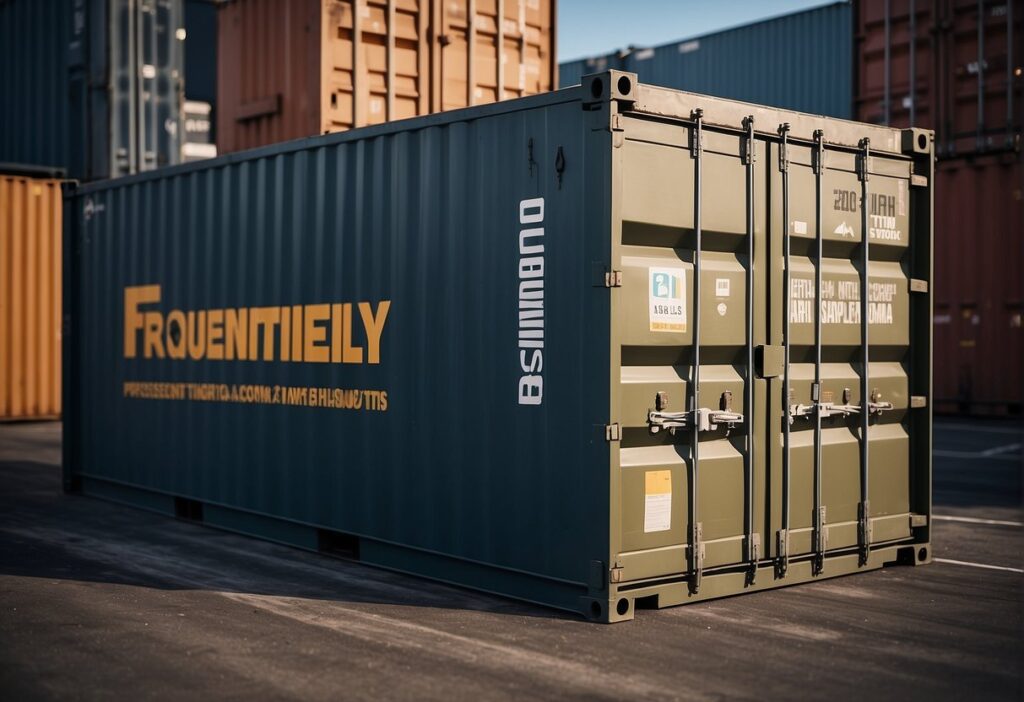The 20-foot shipping container has become a staple in the transport and storage industry, serving a critical role in global trade. These containers, often referred to as Twenty-Foot Equivalent Units (TEUs), are the standard size for various shipping tasks. They offer a balance of space efficiency and capacity, being large enough to hold a substantial amount of goods yet small enough for easy handling and transport. Businesses and individuals alike use these containers for shipping a wide range of cargo, as well as for on-site storage and even as a foundation for building modular structures.

Regarding their construction, 20ft shipping containers are made from high-strength corten steel, known for its excellent durability and resistance to the harsh conditions at sea. The dimensions of a standard 20ft container typically measure about 20 feet in length, 8 feet in width, and 8.5 feet in height, providing a cargo volume of approximately 1,172 cubic feet. Differing slightly in size, high-cube variants add an extra foot in height, enhancing the container’s volume for more substantial storage needs. These containers are engineered to be stackable, weatherproof, and secure, making them an optimal choice for transport via ship, truck, or rail.
Beyond transportation, the versatility of the 20ft container allows for a range of modifications and repurposing. They can be transformed into on-site offices, living spaces, workshops, or pop-up retail shops. Their uniform size and build specifications ensure consistency and compatibility across different manufacturers and shipping services. Whether for commercial shipping, innovative architecture, or practical storage, 20ft shipping containers offer a reliable and adaptable solution.
Overview

The 20ft shipping container is a versatile and widely-used unit in global shipping and storage. Known for its robust construction and adaptability, it caters to diverse industry needs.
Types of 20ft Shipping Containers
There are several types of 20ft containers, each designed for different purposes. The standard (dry) container is the most common, suitable for a wide range of cargo. Refrigerated units, also known as “reefers,” are essential for perishable goods, while insulated containers preserve temperature-sensitive products. Open-top and double-door variants facilitate loading of oversized items or materials that require ventilation. Both new and used containers are available, with used containers often serving as an economical option for storage or modified usage. The 20ft high cube container provides additional height for taller cargo, making it a valuable option for shipping or storage.
Dimensions and Specifications
Dimensions and specifications for the standard 20ft shipping container are as follows:
| Attribute | Value |
|---|---|
| Length | 20 feet (6.06 meters) |
| Width | 8 feet (2.44 meters) |
| Height | 8 feet 6 inches (2.59 meters) |
| Type | ISO steel container |
The 20 ft high cube container has a height of 9 feet 6 inches (2.90 meters), providing extra volume. Steel is the predominant material for these containers, ensuring durability and security for shipping and storage. The various types of 20ft shipping containers, whether new or used, serve multiple functions, from transporting goods across oceans to providing additional on-site storage solutions. The condition of used containers can vary, but they still offer robustness as they adhere to ISO steel container specifications.
Applications

The versatility of 20ft shipping containers lies in their robust construction and standard dimensions, making them a go-to solution for a myriad of applications across commercial, residential, and specialized sectors.
Commercial Use
20ft shipping containers serve as an economic storage solution for businesses, offering ample space to house bulk grains, recyclables, or surplus stock. Retailers often utilize these containers as additional office space, capitalizing on their modular nature. Companies like Pelican Containers provide CSC certified and ISO-compliant units that ensure logistics requirements are met with ease.
- Storage Solution for Inventory: Ideal for storing products and equipment.
- Custom Office Containers: Can be modified to include windows, doors, and insulation for office use.
Residential Use
Not merely for commercial entities, 20ft containers have been transformed into innovative residential storage solutions and unique living spaces. They cater to homeowners requiring extra space or those aspiring to possess a modern, minimalist abode.
- Residential Storage: Secure storage for furniture, tools, and personal items.
- Custom Living Spaces: Modified containers with amenities for compact living.
Specialized Use
The structural sturdiness of 20ft containers makes them suitable for housing large generators, engine parts, and machinery for industries. Some containers even morph into restaurants or guard shacks, showcasing their adaptability to specialized applications.
- Equipment Housing: Perfect for safeguarding sensitive machinery from the elements.
- Specialty Conversions: From foodservice to security checkpoints, containers are customizable for various niche needs.
| Dimensions | Length | Width | Height |
|---|---|---|---|
| External Dimensions | 20ft (6.06m) | 8ft (2.44m) | 8.5ft (2.59m) |
| Internal Dimensions | 19.4ft (5.9m) | 7.7ft (2.35m) | 7.9ft (2.39m) |
Businesses and individuals alike can entrust 20ft containers to effectively manage space and logistics challenges, whether it’s for storage, workspace, or bespoke configurations.
Buying Guide

When purchasing a 20ft shipping container, it’s essential to weigh your options and consider numerous factors to ensure you get the best value for your needs. This buying guide will help you navigate the purchasing options and key factors to keep in mind during your decision-making process.
Purchasing Options
The market offers both new and used 20ft shipping containers for sale. Buyers should decide whether they prefer a brand-new container, which typically comes with a warranty and the assurance of pristine condition, or a used container, which can be more affordable but may vary in terms of condition.
- New Container: Guarantees a structurally sound container with no prior wear and tear.
- Used Container: Ranges from like-new (cargo-worthy containers) to those with potential defects; often a more cost-effective solution.
Factors to Consider
When selecting a 20ft shipping container, several factors should influence your decision. Here is a breakdown of key considerations:
| Factor | Description |
|---|---|
| Price & Budget | Evaluate the container’s cost against your budget constraints. |
| Quality | Assess the quality, including whether the container is cargo-worthy and structurally sound. |
| Warranty | Check if a warranty is offered, especially for new containers. |
| Delivery | Confirm delivery options and fees, ensuring they fit your requirements. |
| Maximum Load | Consider the maximum load capacity to ensure it meets your cargo needs. |
| Lockbox | Look for security features, such as a lockbox, to protect your cargo. |
Purchasers should ensure the container is cargo worthy, implying it can safely transport goods across long distances. Additionally, verify that the selected unit is structurally sound to prevent any issues with transportation or storage.
Adaptations and Modifications

When considering a 20ft shipping container, the capacity for adaptations and modifications makes it an incredibly versatile option for various applications. These containers can be transformed to serve as open-top containers, high cube containers, refrigerated units, or customized office spaces.
Customization Options
Shipping containers traditionally used for the dry transportation of goods can be customized to meet specific needs. For instance, high cube containers, which offer additional height, provide extra space to accommodate taller items or additional shelving for storage. The adaptability of 20ft containers also allows for the integration of side doors, enhancing accessibility to the contents and improving the ease of loading and unloading goods.
| Feature | Benefit |
|---|---|
| Open-top | Simplifies the process of loading bulky items. |
| High cube design | Provides more vertical space for stacking or equipment. |
| Side doors | Offers multiple points of entry for better access. |
Additional Features
Moreover, there are additional features such as refrigeration that can be installed, which enables the 20ft container to serve as a portable cold storage unit. The strong and durable build of shipping containers ensures the security and safety of valuable contents, particularly when modified for use as custom office containers that may include windows, doors, insulation, and power.
| Modification | Application |
|---|---|
| Refrigeration | Preserves perishable goods during transportation. |
| Custom office | Tailors a workspace with necessary amenities. |
These containers remain reliable and efficient in their functionality, both in their original form and when adapted for various specialized requirements, highlighting their range in utility and convenience.
Logistics and Transportation

In the realm of international shipping, 20ft shipping containers represent an industry standard due to their adaptability and efficiency in logistics. They facilitate intermodal transportation, which is essential for a streamlined global trade system.
Shipping and Handling
International Delivery: The 20ft shipping container is pivotal for international delivery services. Their uniform size and durability ensure goods are protected during long voyages across seas. Industry Standards: As an internationally recognized standard, these containers simplify customs processes and help maintain consistent customer service quality.
Loading and Unloading
Intermodal Transportation: The design of 20ft containers enables easy transfer between ships, trucks, and trains, optimizing logistics by minimizing the need for direct handling of the goods inside. Ease of Loading: Their dimensions cater to efficient space usage while being easy to load and unload, which reduces turnaround times at ports and transport hubs.
| Dimensions | Metrics |
|---|---|
| Length | 20 feet |
| Width | 8 feet |
| Height | 8.5 feet |
Table: 20ft Shipping Container Dimensions
Through these features, the 20ft container remains an integral component of modern transportation and logistics networks.
Legal and Regulations
When dealing with the procurement and use of 20ft shipping containers, individuals and businesses must navigate a variety of legal and regulatory landscapes. These requirements ensure containers meet international standards for safety and suitability for intermodal transportation.
Certifications
Shipping containers, including the 20ft variety, must adhere to ISO (International Organization for Standardization) certifications. ISO classifies containers as ISO steel containers, ensuring standardization in dimensions and structural integrity. Specifically, a 20ft container is designated as an ISO 668 Series 1 freight container, standardized in terms of dimensions, corner fittings, and resistance to the various stresses encountered during shipping.
Table 1: 20ft ISO Steel Container Dimensions
| Type | Length | Width | Height |
|---|---|---|---|
| Standard 20ft | 19′ 10.5″ | 7′ 8.5″ | 7′ 6″ |
| High Cube 20ft | 19′ 10.5″ | 7′ 8.5″ | 8′ 6″ |
Compliance Issues
Compliance issues often involve adhering to various national and local regulations, which may dictate how a shipping container can be used on land, particularly when repurposing into building structures or storage units. For intermodal transportation, the containers must meet specific industry standards to ensure they can be safely stacked, handled, and transported by different modes of transport such as ships, trains, and trucks. Compliance also involves inspection and approval from maritime authorities and other regulatory entities to verify that containers are fit for international shipment.
Different states or regions may have distinct rules about using these containers, as seen in the responses from local governments to the growing trend of container repurposing. For instance, some jurisdictions provide specific guidelines to ensure safety and compliance with building codes when containers are utilized for construction.
Maintenance and Care

Ensuring the longevity of a 20ft shipping container hinges on regular maintenance and understanding the factors that influence its condition.
Longevity and Durability
20ft steel containers are engineered for endurance, often boasting a lifespan that can exceed a decade with proper maintenance. Their robustness comes from the corrosion-resistant corten steel construction, which also necessitates the need for regular upkeep to maintain structural integrity. Owners should be proactive about inspecting their containers and adhere to a maintenance schedule that aligns with the manufacturer’s warranty.
- Inspection: Monthly checks for rust, dents, and door alignment.
- Cleaning: Bi-annual cleaning to remove debris and prevent corrosion.
- Painting: Application of rust-resistant paint as needed to protect the surface.
Container Condition
The condition of a shipping container is a direct result of how it is cared for. Customers must ensure that the doors seal properly and the container remains watertight. Should any issues arise, prompt attention from customer service can help resolve warranty-related concerns and guide on repair strategies.
- Door seals: Check every three months to prevent leaks.
- Surface rust: Remove immediately to avoid penetration.
| Maintenance Task | Frequency | Notes |
|---|---|---|
| Structural Inspection | Monthly | Check for rust, dents, and proper door alignment. |
| Cleaning | Bi-annually | Focus on both interior and exterior cleanliness. |
| Paint Maintenance | As needed | Use a rust-preventive coating appropriate for the metal. |
| Checking Seals | Quarterly | Ensure doors are watertight to protect contents. |
| Customer Service Check | As needed | Consult for repairs and warranty issues. |
By investing in routine checks and addressing issues promptly, owners can significantly extend the service life of their containers.
Additional Services

When exploring the rental or purchase of a 20ft shipping container, customers can expect more than just the physical product. Providers often offer a range of additional services to enhance the customer experience and meet specific needs.
Customer Support
Providers of 20ft shipping containers prioritize customer support to guide clients through the selection and rental process. They typically offer a quick quote system, which allows potential renters or buyers to receive an estimate swiftly. This service ensures that customers can budget and plan accordingly without delays. Many companies also showcase testimonials on their websites, offering transparency and sharing previous customers’ experiences to build trust with prospective clients.
Extra Services
Besides the standard offerings, some container providers offer a suite of extra services which may include:
- Custom modifications (e.g., shelving, insulation, ventilation)
- Delivery and pickup options
- On-site storage solutions
Container dimensions and specifications are clearly listed to aid the customer in making an informed decision:
| Dimension | Value |
|---|---|
| Length | 20ft |
| Width | 8ft |
| Standard Height | 8ft 6in |
| High Cube Height | 9ft 6in |
Efficient customer service is also a cornerstone of these additional offerings, ensuring that any issues or special requests are addressed promptly and effectively.
Comparison with Other Containers

When examining the 20ft shipping container, it is important to note its distinct features in comparison to other sizes and materials used in the shipping industry.
Versus Other Sizes
The 20ft shipping container, also known as a standard dry container, is widely regarded for its versatility. It stands in contrast to the 40ft containers, which provide double the space, suitable for larger shipments. In particular, the 20ft high cube (HC) container offers an extra foot in height, accommodating taller cargo. The interior dimensions of a standard 20ft container are approximately 19’4″ long x 7’8″ wide x 7’10” high, while for a 20ft HC container, the height extends to 8’10”.
For specialized loads, the 20ft flat rack container with collapsible sides allows for the transport of oversized items that may not fit within the enclosed space of standard containers. Furthermore, pelican containers offer options for customized modifications, both in 20ft and 40ft sizes, to suit unique shipping requirements.
| Container Type | Length | Width | Height |
|---|---|---|---|
| 20ft Standard | 19’4″ | 7’8″ | 7’10” |
| 20ft High Cube | 19’4″ | 7’8″ | 8’10” |
| 20ft Flat Rack | 19’4″ | Variable | Variable |
Versus Other Materials
Most shipping containers, including the 20ft shipping container, are predominantly constructed from steel, ensuring robustness and durability required for harsh marine environments. Steel shipping containers are resistant to corrosion, weathering, and can secure goods against theft and contamination.
On the other hand, some shipping containers are made from alternative materials such as aluminum or a combination of steel and other materials, offering a trade-off between durability and weight. While steel remains the industry standard for its strength, alternative materials may offer benefits in weight savings for certain transport needs. However, the 20ft steel shipping container continues to be a preferred choice for its reliability and ease of handling.
Use Cases
20ft shipping containers provide versatile solutions for various storage and space requirements. They are highly adaptable for both commercial and personal needs.
Case Studies
Storage Solution: Companies often utilize these containers as secure storage for large generators, engine parts, and machinery due to their robust build and extensive capacity. For instance, construction sites frequently employ 20ft containers to store valuable equipment and materials, safeguarding them from weather elements and theft.
Office Space: They are also commonly converted into custom office containers with side doors for easy access. These mobile offices can often be seen at construction sites and outdoor events, providing a necessary workspace in remote locations.
Real-world Examples
Restaurants: In the retail and hospitality sectors, these containers are innovatively transformed into pop-up restaurants or cafes, offering a unique dining experience to customers. Such repurposing involves outfitting a new container with kitchen equipment and designing an inviting atmosphere within a compact area.
Residential Storage: Homeowners may use a 20ft container as a residential storage solution during renovations to store household items securely on their property. It protects belongings from dust and damage while providing ample space.
Guard Shacks: For security purposes, these containers are often modified into guard shacks at the entrances of industrial facilities or large events, serving as a checkpoint for monitoring and controlling access.
| Dimensions | Length | Width | Height |
|---|---|---|---|
| External | 20 ft | 8 ft | 8 ft 6 in |
| Internal | 19 ft 4 in | 7 ft 8 in | 7 ft 10 in |
Serving as multi-purpose units, 20ft shipping containers are routinely chosen for their compatibility with various functional roles and their ease of modification to fit specific needs.
Market Trends and Predictions
The shipping container market, with a focus on the 20ft storage container, is seeing shifts in both quality demands and logistics strategies. This section delves into the current state of the industry and what we might expect moving forward.
Industry Insights
The industry standard for storage containers has historically been oriented toward durability and longevity. Recent market trends indicate an increasing demand for high-quality, new containers, specifically those crafted from corrosion-resistant steel. The 20ft container, a staple in global logistics, continues to be a popular choice due to its versatility in transportation and storage capacity. For logistical operations, these containers represent a blend of manageability and storage efficiency.
| Dimensions of Standard 20ft Container |
|---|
| Length: 20ft (6.06m) |
| Width: 8ft (2.44m) |
| Height: 8.6ft (2.59m) |
| Volume: 1,172 cu ft (33.2 m³) |
| Tare Weight: 4,916lb (2,230 kg) |
| Payload Capacity: 47,999lb (21,770 kg) |
The table above provides specifics on dimensions that have become an industry standard for 20ft steel containers, maintaining uniformity across the board for shipping and storage solutions.
Future Developments
Looking to the future, the industry anticipates developments in both the construction and utilization of 20ft containers. There is an expectation for an evolution in industry standards to accommodate a higher emphasis on sustainability. This could lead to the integration of newly designed containers that feature eco-friendly materials and enhanced energy efficiency during production. In the realm of logistics, technological advancements are predicted to streamline operations, with enhanced tracking systems and automated handling becoming more prevalent. These future developments aim to bolster the efficiency and environmental footprint of the global supply chain.
Frequently Asked Questions

The dimensions, cost, and features of 20ft shipping containers are important considerations for potential buyers. Here are several common questions and clear, confident answers regarding these versatile storage units.
What are the standard dimensions of a 20ft shipping container?
A 20ft shipping container typically measures about 20 feet in length, 8 feet in width, and 8 feet 6 inches in height externally. Internally, the dimensions may be slightly less due to the thickness of the walls.
How much does a typical 20ft shipping container cost?
The cost can vary widely based on factors like condition (new or used), location, and the seller. Pricing is market-dependent and subject to change, but a range could be anywhere from a few thousand dollars for used containers to higher for new or customized units.
Can a standard car be accommodated inside a 20ft shipping container?
Yes, a standard car can generally be accommodated inside a 20ft container. These containers offer sufficient length and width to house most standard vehicles, which is beneficial for international vehicle shipping.
What is the maximum weight capacity of a 20ft shipping container?
The maximum gross weight of a 20ft shipping container can go up to about 67,200 pounds (30,480 kilograms), but the payload capacity—the weight of the cargo it can carry—is typically around 48,000 pounds (21,727 kilograms).









